Assassin’s Creed Unity Review
Assassin’s Creed Unity Review
The grittiest and prettiest Assassin's Creed yet
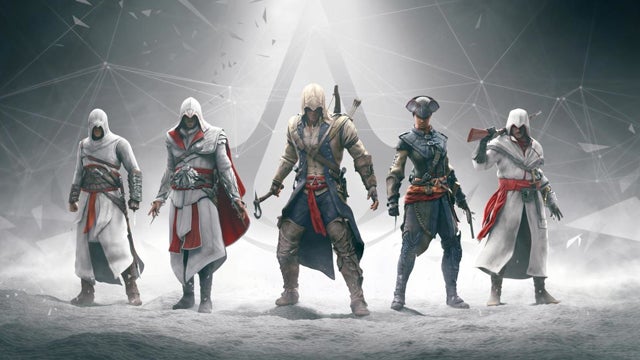
Verdict
Pros
- Stunning recreation of French Revolution Paris
- Hundreds of hours of content
- Strong storyline
Cons
- Control system still isn’t perfect
- Still a few bugs to be fixed
Key Specifications
- Review Price: £49.99
Available on PS4, Xbox One and PC
If we can say one thing about Assassin’s Creed Unity, it’s that it is the most beautiful of the series’ entries so far. It’s the first game that has been developed solely for new-gen Xbox One and PS4 consoles and PC and it shows in every pixel. That’s not something that hasn’t been captured in other Assassin’s Creed titles, it’s just something we have come to expect when purchasing an Ubisoft game nowadays.
But Assassin’s Creed Unity takes those aesthetics to a whole new level.
Watch the Assassin’s Creed: Unity trailer
Light bounces off the rivers, carves shadows across the buildings and as it turns to night, you see the Parisian landscape aglow with lamp fire. The buildings themselves are supposedly 1:1 scale and it shows. Walk into the Notre Dame you’ll see ceilings arch above you. Climb to the top one of Paris’ many towers or scale the Notre Dame
itself and you’ll notice how much detail and passion has gone into
building this game and infusing it with life and history.
The streets are packed with more NPCs than we’ve ever seen in a game. They throb in vast numbers in central squares below the Notre Dame or to watch the latest guillotine sessions, meaning you’re often pushing through civilians to get to your goal, or using them to blend in and assassinate silently. It’s partly the sheer number of citizens that gives Unity’s Paris its soul. The noise of the crowds’ French voices fill your ears, with the sounds of daily life adding to the soundscape.
But that is undercut by the Cockney or Yorkshire accents of the guards and police respectively. It seems strange that they sound so very British against the French citizens, especially when you hear them call you a “pillock” or asked if you’ve soiled yourself recently.
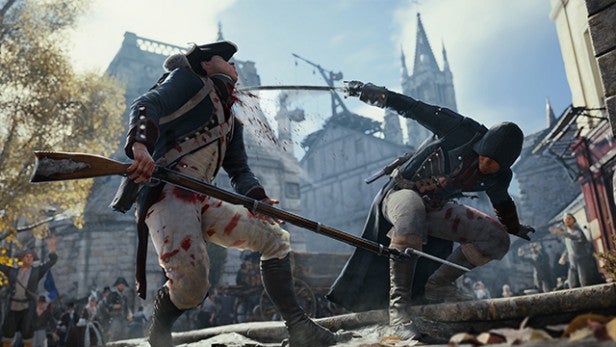
You will explore Paris and its many delights as Arno Dorian, who is a newly initiated Assassin in the middle of French Revolution Paris. Arno is a strong-headed, cocky individual who has distinct similarities to our favourite assassin, Ezio Auditore da Firenze, from Assassin’s Creed 2 – which is always a good thing.
Unity follows Arno’s life from a young boy to the peak of his Assassin’s career and it’s one of the most compelling and strongest that we’ve seen from an Assassin’s Creed game for some time, especially at the beginning. That said, and we won’t ruin it for you whatsoever, you do come away at the end credits a little disappointed – and you’ll see what we mean when you get there.
You won’t see much of Versailles during the main campaign, but it is always there if you wish to visit it. Paris is where you’ll be spending nearly all your time, and a lot of time too. We’ve sunk over 50 hours into the game at this point and it’s hard to see any of the map at a distance for all the markers for available side-missions, collectible, chests, co-op opportunities or other such quests.
It’s the biggest and most densely packed of the Assassin’s Creed worlds, which is in part helped by the fact you can go inside a large number of the buildings. Often chests and missions can only be found tucked away inside the various homes. When climbing using RT, pulling LT will make Arno swing inside windows – often with little success we might add. The fact that the buildings are much more than just shells or building blocks also helps make this the most engaging and realistic Assassin’s Creed yet.
SEE ALSO: Assassin’s Creed Unity tips and tricks
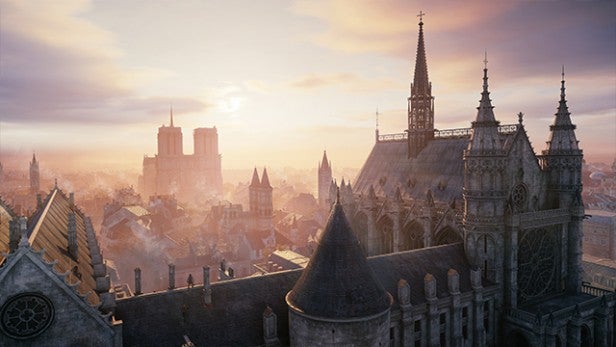
The real focus of Assassin’s Creed Unity is its enhanced sense of freedom. The main storyline missions have been revamped so that you have total control of how you approach missions. Major assassinations now take an open fortress format where Arno perches himself on a nearby lookout point and surveys the area. He’ll mark out distraction opportunities or alternate entrances that you might want to take advantage of, and from there it’s up to you how to handle the mission.
With each mission you’ll be presented with optional objectives too, such as taking out a number of guards from cover or hiding points, performing double air assassinations or sabotaging alarm bells. You’ll need to tick all the boxes if you want to 100 per cent each mission (especially if you’re OCD like us) and if you want to earn the full reward for each one.
Some of these will require specific skills, which are a key part of Assassin’s Creed Unity. In the Player Customisation screen you’ll see a Skills option, where you’ll find a number of skills split into four distinct categories – Melee, Ranged, Stealth and Health.
We found the Stealth skills the most helpful, as it gave us lockpicking abilities for alternate entries into buildings and for unlocking red chests. Plus, you’ll need to unlock certain skills to have abilities that other assassins like Edward Kenway had as standard – environmental blending, double assassinations, double air assassinations and roll recovery for long falls for example.
SEE ALSO: Far Cry 4 tips and tricks
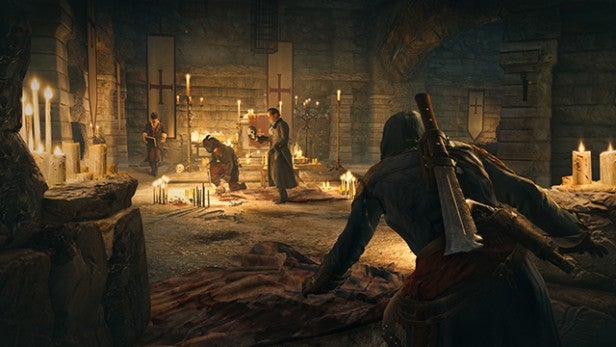
Skills are unlocked using Sync Points, earned through campaign and co-op missions/heists. Sync Points are just one of the game’s four currencies, which can be quite tricky to work out at first. The main currency is French Livre, which you’ll use to buy weapons, gear and other items. But then you have Sync Points, Creed Points for weapon and gear upgrades and Hack Points. These are the shortcut currency, which can be purchased using microtransactions (sadly) and get you lots of high-level gear a lot quicker. If you unlock all the Social Houses and the Café de la Theatre though, you’ll be raking in the cash in no time, meaning having that microtransaction option really isn’t necessary.
The open-ended missions are a refreshing change for the Assassin’s Creed series. Armed with your customised Arno, you really do have the freedom to carve your own path. This enhanced freedom is also aided by the way Ubisoft has revamped two key areas of gameplay in Unity – combat and free-running.
The control structure has been completely streamlined, making it far easier to traverse Paris at speed. Pulling on the right trigger still puts Arno in free-running mode, but now you climb up or down by pressing one of two buttons. He’ll automatically climb if you’ve got RT pressed, but hold down A (or X on PS4) as well and he’ll jump higher and further with increased skill.
But, the real change comes to climbing down. There’s still bizarrely placed hay bales to swandive into from rooftops, but if you press B (or circle on PS4) with RT then you’ll find Arno descends the buildings at speed, finding handholds and other grip points to quickly get to ground level.
For those familiar with Assassin’s Creed games, this will seem odd at first and take a little while to familiarise yourself with. But, once you have, it’ll feel like second nature and make your Parkour skills – and therefore your stealth abilities too – second to none.
There can still be a few frustrations, though. Although it’s near impossible to accidentally leap to your death, it can be tricky to push Arno from one wall and across a gap to another. Plus, Ubisoft has chosen to add a few animals into the crowds, like dogs and goats, which act as solid, immovable objects that you can’t climb. That means, if you run into one at pace, you stop dead in your tracks and can get stuck entirely.
Also, you can find yourself stranded on a point at times, unable to climb up or down, even by the route you came by. The control system has definitely improved upon previous series instalments, but there’s still a few irks to iron out yet.
See also: Best Xbox One Games 2014
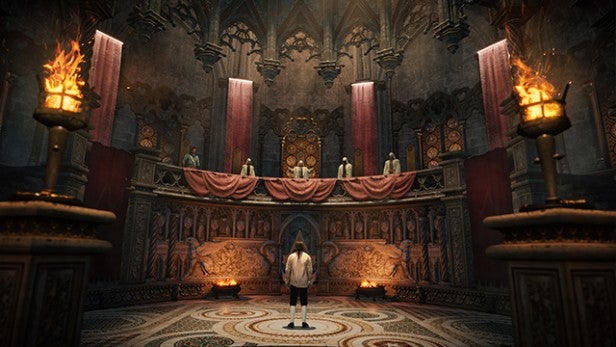
Tweaks have been made to the combat system too and for those who have played games like Batman: Arkham Asylum there are definite similarities. You can no longer just spam your defensive move and take out swathes of enemies. The combat is far more challenging in Unity, because you’ll find enemies flank you from all sides. Even if you’ve mastered all the counters and parry moves, you might just find yourself outnumbered and need to use a smoke bomb to make a swift escape.
You’ll need to learn quickly that there are different types of enemies too, which can take you down in one blow if you’re not quick to parry or dodge their heavier blows. That’s where Eagle Vision comes in. It was present in all other Assassin’s Creed games, but in Unity, the technique really comes into its own. In fact, it’s such an invaluable skill that you’ll be hammering Y (or triangle on the PS4) as soon as it’s available after a brief cool down period.
Eagle Vision sweeps through the area highlighting guards (and their weapons) in red, police officers in blue and potential allies in green. Any assassination targets will be marked in yellow, along with distraction opportunities. They’ll show up through walls too, meaning you can plan how to make your make next move in missions.
Be warned, if you find yourself repeatedly failing to finish a mission, it’s the game giving you a sign you might want to find a different tack. You’ll quickly realise that enemies will spot you faster if you keep trying the same tactics. The enemy AI in Unity is far more intelligent than you give them credit for.
You’ll need to utilise all your acquired skills, hiding points, cover kills and other gadgets like smoke or cherry bombs to complete each mission. Take out as many guards as you can, because it’ll make your eventual escape a lot easier.
SEE ALSO: Sunset Overdrive tips and tricks
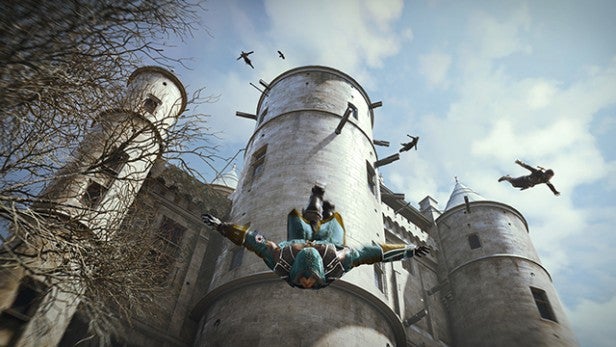
As you start playing, you’ll also quickly realise that Unity is the most gruesome of the Assassin’s Creed games. Blood flows from the veins you just opened in each enemy, meaning soon you’ll be painting the town (and its inhabitants) red in the goriest of manners. We often found Arno sporting a rather horrific blood smeared face in campaign cut-scenes, just to highlight how many guards you’d killed just moments before.
Another thing to consider is that the visual enhancements introduced with Unity aren’t just to make it look beautiful. The game has a dynamic day and night cycle, as well as the occasional rain storm. But the lighting can affect how you approach missions as well. Moving from interior to exterior locations in the middle of the day will cause visibility issues. Try and emerge from a darkened room through a window and you’ll be blinded for a few seconds until Arno’s eyes adjust to the daylight, which can be quite an issue when you’re trying to take out a guard standing watch outside. The level of detail in this game can be quite awe-inspiring at times and not just because of the blood bath.
SEE ALSO: Alien Isolation tips and tricks
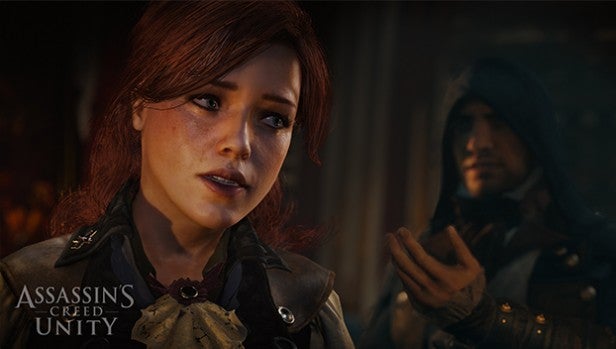
Arno’s story is fragmented by the Time Shifts that you might have seen in one of the more recent AC Unity trailers. Unlike previous Assassin’s Creed games, you never have any sections where you don’t play as Arno. Instead, there are points in the story where Bishop and the guys on the other side help you escape as Abstergo tries to find you in the Animus, leading to Time Shifts where you’re transported to a different era.
These Time Shifts are probably the most linear sections of the storyline, but they are a glimpse at what alternate Paris landscapes could look like. We won’t ruin them, or any plot points in the story, because it’s one of the best Assassin’s Creed storylines yet.
We would add that you shouldn’t just complete the story missions one after the other. Paris has a huge amount of side missions and collectibles to explore and you’ll want to intersperse different mission types. While the main campaign missions are engaging, the open-ended fortress style missions can become a little repetitive towards the end of the story. Most gamers will do this automatically, but if you just focus on the campaign it can become a little monotonous if you don’t vary your mission types.
SEE ALSO: Minecraft tips and tricks
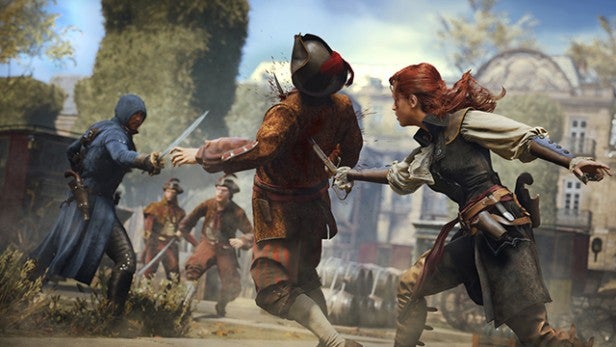
But that’s incredibly easy to do in Assassin’s Creed Unity. Paris is full of side missions to complete. The main type are known as Paris Stories, which will see you undertake quests such as collecting decapitated heads for Madame Tussaude or taking out rival pimps for the Marquis de Sade. There are around 50 of these alone, and they’ll keep you busy for hours on end. Plus, some of them are actually quite comical too.
What Unity also does incredibly well is teach you French history. The Murder Mystery side missions take you on a journey to solve the murder of various citizens, all of which are based on real murders in 18th Century Paris.
Plus, there’s the Nostradus missions, which present you with a riddle to solve based on famous Parisian landmarks. We really struggled with these, as they require either an amazing knowledge of French history, or a lot of time dedicated to the incredibly well-written Unity Database contained within the options menu.
There’s also Social Club and Café Theatre missions to follow, which if you unlock the Café and the clubs you’ll start to bring in quite the income from. Meaning lots of shiny new weapons and gear for you to don.
You’ll also notice that there are society mini-missions that pop up as you run around Paris. Sometimes Arno will be asked to chase down thieves, kill enemies or scare off bullies for the citizens. Once you’ve done this enough times, you’ll earn yourself some nice rewards.
Of course, Paris is also full to the brim with collectibles. There’s cockades, artefacts and chests of various colours to seek out. The chests require different skills to unlock: red ones require lockpicking skills; blues need to be opened by using the Assassin’s Creed Unity Companion app; gold chests need to be unlock using the Assassin’s Creed Initiates website, while white can be opened at any time with no specific skills.
See also: The Evil Within tips and tricks
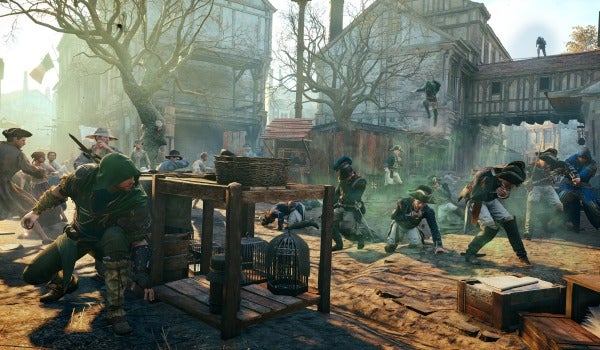
While Assassin’s Creed Unity still feels like a strongly single-player game, Ubisoft has introduced four-player co-op to the series. Co-op missions are available around an hour or so into Unity and can be played solo, but you’ll usually a few friends in tow for the harder missions.
Like the single-player campaign, each mission is given a diamond rating and those with a higher diamond count will put you up against an increasingly difficult scenario. Most missions are for two to four players, and they’re incredibly fun to play with friends.
Co-op missions either take the form of stand-alone campaign missions with their own storyline and characters, or heists. The heists require you and your pals to infiltrate an open-ended fortress to take out various enemies within. You’ll all need to use your skills to complete the mission successfully, with some of the five diamond missions requiring high levels of skill and a lot of communication.
The co-op missions do well to extend Unity’s storyline beyond the main campaign. They introduce new characters and challenges even when you’ve completed all the main missions and can be played over and over again. Currently, there’s ten co-op missions and seven heists to complete, which should hopefully be expanded upon in the future.
There’s no denying that you’ll spend multiple days playing Unity on your own, but there are times when being an assassin is a lonely feeling. So grab some mates and have some fun taking enemies down together. It’s a fun way to experience Unity.
SEE ALSO: Best PS4 games
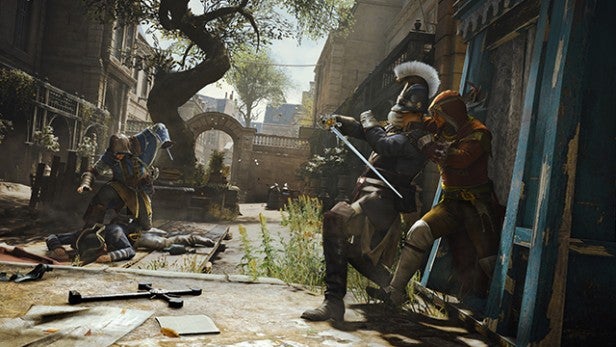
Now, although Unity is vast, ambitious and jam-packed full of things to do and find, it’s not without its flaws. Even after a Day One patch, we still had times where we could dive off a building and find Paris and its people had disappeared entirely, leaving us to dive into the abyss and desynchronise.
There were also points where NPCs would spontaneously appear or disappear right before our eyes. Some may think because of the sheer amount of people in Unity, a few having issues may be forgiven, but when one appears right in front of you on a rooftop, it does jar a little.
Unity is also at times very, very frustrating. The fact that enemies will learn your favoured combat techniques and remember your entry points if you use them too often is equal levels clever and irritating. It’s more apparent in later missions, though, and often taking on a side mission and coming back later is the best answer.
Next, see our pick of the Best games of 2014
Verdict
Assassin’s Creed Unity feels like the perfect starting point for gamers new to the series. It’s the pinnacle of the series in so many ways and the revamped combat and control systems make it accessible to all gamers.
The new RPG elements also work well to add a level of customisation options to the gameplay, and the open-ended missions are definitely a welcome focus. You finally feel like a real assassin who is in control of their weapons and skills.
Plus, this is the most stunning game we’ve played to date on both the Xbox One and PS4. Lighting effects will make you stop and think about the location you’re running through, while the interwoven history will take you on a very different journey.

